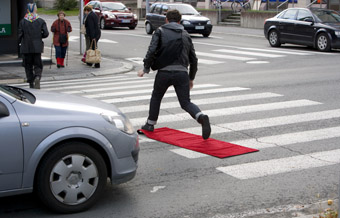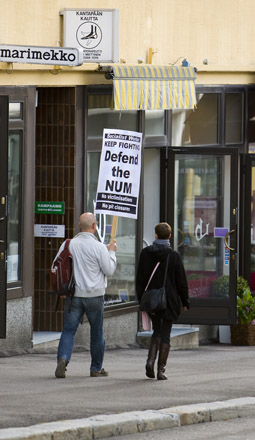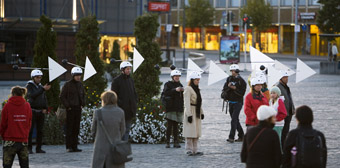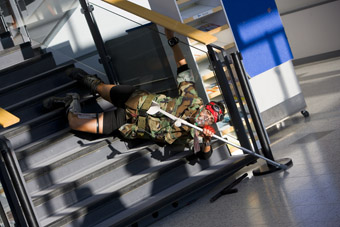walkers re-write city
helen cole: anti festival 2009, kuopio, finland

The Red Carpet Treatment, Vincent Chevalier; ANTI – Contemporary Art Festival, Kuopio, Finland
photo Pekka Mäkinen
The Red Carpet Treatment, Vincent Chevalier; ANTI – Contemporary Art Festival, Kuopio, Finland
I AM IN KUOPIO, FINLAND AT ANTI, THE INTERNATIONAL LIVE ART, SITE-SPECIFIC FESTIVAL THIS YEAR CONTEMPLATING WALKING AS PERFORMANCE, AS A WAY OF UNCOVERING THE STORIES OF THE CONTEMPORARY CITY AND RECONFIGURING PUBLIC SPACE.
I approach the city as an outsider, a curator who already recognises the potential of live art to uncover schisms through which new meaning can emerge. However, I have never before seriously thought of walking as an act of transformation. I have legs, a map and some artists to guide me and through my own act of mundane motion I hope to discover an alternative city, a place that sits just outside usual perspective, recognisable but shifted into something moving or profound.
I have no previous experience of Kuopio, no prior affinity or particular empathy. My first impressions are of autumnal change, days caught between seasons with people in big hats and stout boots. Teenagers hang in bus stops and in the early hours old ladies wheel bikes through impressively drunken throngs hugging the pavements. In All the Demos I’ve Ever Been On, my partner Alex Bradley (UK) stomps the street in a repeated oblong for five days, a solemn, solitary demonstration of his own history of political activism. Transposing Kuopio for London, Kauppakatu becomes Embankment and Kaupungintalo the Houses of Parliament.

Every demo I’ve ever been on (1985-2009), Alex Bradley; ANTI – Contemporary Art Festival, Kuopio, Finland
photo Pekka Mäkinen
Every demo I’ve ever been on (1985-2009), Alex Bradley; ANTI – Contemporary Art Festival, Kuopio, Finland
For the first few days Bradley is quietly insulted or largely ignored by Kuopio’s residents. With constantly changing placards that scream defiance in clipped English sentences, he relentlessly supports the working class, long-gone British industry, the marginalised, the victimised and the poor. He supports the Miners’ Strike of 1984, the Ambulance Workers and the NHS [National Health Service], protests against the Poll Tax, Apartheid and Clause 28 [which prohibited local authorities from promoting homosexuality; enacted 1988, repealed 2000-03]. On his fourth and fifth days his placards shout of the global anti-war movement and at this point the people of Kuopio gently start to wake up. A police car idles past repeatedly, a punk shows him a victory sign, an older man shouts “Bless You” while another gives the thumbs up. We are told there is no significant history of public protest in Kuopio or indeed more widely in conservative Finland, but in the confusing mess of reaction and interaction Bradley’s 48 mile demonstration seems like it is starting to be noticed, just at the point it’s about to be gone. As he puts down his last placard a series of questions hangs in the air above the route of his protest, who are the Finnish disenfranchised, what statements fill their placards, whose future voices will rise to be heard?

Live Windwalks, Tim Knowles; ANTI – Contemporary Art Festival, Kuopio, Finland
photo Pekka Mäkinen
Live Windwalks, Tim Knowles; ANTI – Contemporary Art Festival, Kuopio, Finland
What do the market squares, shopping centres, parks and harbours of Kuopio mean to the artists, these outsiders? Will they rewrite these streets as they tread themselves into the tarmac and earth? Tim Knowles’ Windwalk (UK) takes place in a violet market square as the sun sets and a collection of participants gather with comical helmets and sails on their heads. The instructions are liberating and simple. Follow the wind and go as far as it takes you. Let the sails lead you through the streets, around all obstacles. People scatter like pollen, grouping then dispersing, caught in eddies and dark corners until one or two are freed on the outskirts of the square to range around the city, ignoring normal routes or obstructions in a kind of free fall with feet firmly on the ground. The work is a delightful statement of otherness and freedom in a city that appears not to mind either. One woman apparently travels miles before stopping in darkness against a wall.
Experiencing Rotazza’s theatrical illustration of a supermarket, Wondermart (UK), there was one single moment—when I was asked to open a fridge, stare at the white plastic and feel the frozen air—I found utterly transporting. Mostly however, I found the work predictable. Seduced by the tinned reindeer meat and weird mushrooms on the shelves before me, I embarked on an adventurous walking project of my own through the market. On the street, Vincent Chevalier unfurls a simple red carpet before him throughout his five days in the city (The Red Carpet Treatment, Canada). To see the artist approaching from a distance in slow chaotic determination is like watching a relentlessly bobbing minor television personality who remains just a little bit apart from the rest of us. It is a funny work of public endurance and there really are not too many of those.
Even in Kuopio the streets can be brutal. Despite the differences in their work, all the festival artists mention the pain and fear of being alone, of being vulnerable and the pressure of forever being on show. They talk of keeping to the path, following the map and ensuring always to bed down in safe places. They know their bodies’ limits. Blisters, wet feet, insect bites or any other minor affliction could ultimately finish the work. None of them speak of extreme acts of endurance but more of deliberately paced endeavours designed to push them on. The road acts as a score and their eyes are fixed on the approaching horizon, or what’s around the next corner or on the small path trodden by adventurers before them and passing less obviously between the bins, parked cars or trees.

Roberto Sifuentes, The “Pocha Nostra” performance intervention brigade, Kuopio airport; ANTI – Contemporary Art Festival, Kuopio, Finland
I see La Pocha Nostra (US/Mexico) who have sought out a covered walkway between fast food joints and department store to one side of the main market square. Here the public move quickly and tell of dealers and streetfights as the young and disaffected congregate in the glare of shopping centre lights. Five La Pocha Nostra characters enter, like barbarians from a freezone with identities distilled and distorted. A young Finnish punk faces off the genuine article, Guillermo Gomez Pena, in wheelchair, tulle skirt and head-dress with wise, black khol-rimmed eyes. Roberto Sifuentes dressed in military fetish wear shivers as he inserts saline solution into his eyes, spurting the water onto the pavement until the tears really come. A sign announces he has served in Iraq and seeks resident status in Finland. His ritualised plea, or apology, is largely ignored by passers-by. The artists remain long after the festival audience has departed and I realise we are not the intended participants. As the sun sets behind us only Kuopio’s punks float in fascination, temporarily giving over their territory in half-understanding as the temperature plummets.
Place is not static, it is rewritten by the performances that happen each day. I wonder if the psyche of Kuopio has been changed by the eight years that ANTI has been playfully interfering with its solid structures and tidy grid-like paths. I notice the public, their performances of not-looking played out in sideways glances or speedy road-crossings in the face of ANTI’s strange artistic goings on. In Bodycartography (US), a woman is framed by the dirty ramp into a car park as she bends double. Another woman hugs a bin for 10 minutes while a man lies on the pavement with a lamppost between his legs. How much do the artists disrupt the domestic goings-on? A few cars crawl past and a lady in a fluorescent track suit walks quickly as though she is part of the weird passing circus, but she is not. A normal town, on a normal day.
On a beautiful bright day, I walk with Stephen Hodge (UK) in SLaaristokaupunki [http://2ndlive.org/projects/slaaristokaupunki.php]. We leave the sensory overload of the outside world to enter a bland office space and sit before a laptop, a doorway into Second Life. Here I enter an island and walk under water without oxygen, traipse a beach without feeling the sand between my toes. I teleport from my island back to the beginning but with no sense of movement, time or distance. I leave Hodge’s’s guidance, Second Life and the office building to walk by the lake in the white light and perfect blue of the morning. It seems almost like dream space, caught between real and virtual, its lines so perfect and colours so precise. As much as I’d like to, I cannot teleport but I take comfort from the concrete certainty of the road and my heart thumping as I walk uphill.
At ANTI I find an adventurous spirit and strike out into the unknown. I give myself permission to walk where, when and however I damn choose. I walk without trepidation and look to the horizon where I meet helpful strangers. I discover beauty because I have looked for it. I find adventure in ordinary, wild or dirty landscapes. I am now a walker and I will only whisper the stories of my own vulnerability, of the darkness and its dangers, the bears and wolves that might lurk therein.
ANTI Contemporary Art Festival, Kuopio, Finland, Sept 23-27, 2009
Helen Cole will present Collecting Fireworks, a growing archive of Live Art, as a Members Event as part of Performance Space, ClubHouse program, Sydney, March 2-3 and at Artshouse, Melbourne, March 17-19
RealTime issue #95 Feb-March 2010 pg. 19






